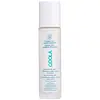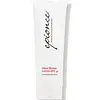What's inside
What's inside
 Key Ingredients
Key Ingredients

 Benefits
Benefits

 Concerns
Concerns

 Ingredients Side-by-side
Ingredients Side-by-side

Water
Skin ConditioningZinc Oxide
Cosmetic ColorantCaprylic/Capric Triglyceride
MaskingPolyhydroxystearic Acid
EmulsifyingDimethicone
EmollientAloe Barbadensis Leaf Juice Powder
Skin ConditioningButylene Glycol
HumectantCaprylyl Glycol
EmollientCetearyl Alcohol
EmollientDidecyldimonium Chloride
EmulsifyingGlyceryl Caprylate
EmollientGlyceryl Stearate Citrate
EmollientHydroxyethyl Acrylate/Sodium Acryloyldimethyl Taurate Copolymer
Emulsion StabilisingJasminum Sambac Leaf Cell Extract
MaskingMethylpropanediol
SolventNiacinamide
SmoothingPEG-7 Trimethylolpropane Coconut Ether
EmulsifyingPolyisobutene
Polyquaternium-80
CleansingPropanediol
SolventSchinus Molle Extract
Skin ProtectingSorbitan Isostearate
EmulsifyingTheobroma Cacao Seed Extract
AntioxidantWater, Zinc Oxide, Caprylic/Capric Triglyceride, Polyhydroxystearic Acid, Dimethicone, Aloe Barbadensis Leaf Juice Powder, Butylene Glycol, Caprylyl Glycol, Cetearyl Alcohol, Didecyldimonium Chloride, Glyceryl Caprylate, Glyceryl Stearate Citrate, Hydroxyethyl Acrylate/Sodium Acryloyldimethyl Taurate Copolymer, Jasminum Sambac Leaf Cell Extract, Methylpropanediol, Niacinamide, PEG-7 Trimethylolpropane Coconut Ether, Polyisobutene, Polyquaternium-80, Propanediol, Schinus Molle Extract, Sorbitan Isostearate, Theobroma Cacao Seed Extract
Homosalate 9.95%
Skin ConditioningEthylhexyl Salicylate 5%
UV AbsorberZinc Oxide 10.1%
Cosmetic ColorantC12-15 Alkyl Benzoate
AntimicrobialAmmonium Acryloyldimethyltaurate/Vp Copolymer
Butylene Glycol
HumectantCaprylyl Glycol
EmollientCaprylyl Trisiloxane
Skin ConditioningCetearyl Alcohol
EmollientDatem
EmollientDimethicone
EmollientEthylhexylglycerin
Skin ConditioningGlycerin
HumectantHexylene Glycol
EmulsifyingHydrogenated Polybutene
Hydroxyethyl Acrylate/Sodium Acryloyldimethyl Taurate Copolymer 1%
Emulsion StabilisingLinum Usitatissimum Seed Oil
PerfumingMalic Acid
BufferingLimnanthes Alba Seed Oil
Skin ConditioningPhenoxyethanol
PreservativePolyhydroxystearic Acid
EmulsifyingPolysorbate 80
EmulsifyingCarthamus Tinctorius Seed Oil
MaskingSteareth-2
EmulsifyingSteareth-21
CleansingTriethoxycaprylylsilane
Trimethylsiloxysilicate
EmollientWater
Skin ConditioningHomosalate 9.95%, Ethylhexyl Salicylate 5%, Zinc Oxide 10.1%, C12-15 Alkyl Benzoate, Ammonium Acryloyldimethyltaurate/Vp Copolymer, Butylene Glycol, Caprylyl Glycol, Caprylyl Trisiloxane, Cetearyl Alcohol, Datem, Dimethicone, Ethylhexylglycerin, Glycerin, Hexylene Glycol, Hydrogenated Polybutene, Hydroxyethyl Acrylate/Sodium Acryloyldimethyl Taurate Copolymer 1%, Linum Usitatissimum Seed Oil, Malic Acid, Limnanthes Alba Seed Oil, Phenoxyethanol, Polyhydroxystearic Acid, Polysorbate 80, Carthamus Tinctorius Seed Oil, Steareth-2, Steareth-21, Triethoxycaprylylsilane, Trimethylsiloxysilicate, Water
Ingredients Explained
These ingredients are found in both products.
Ingredients higher up in an ingredient list are typically present in a larger amount.
Butylene Glycol (or BG) is used within cosmetic products for a few different reasons:
Overall, Butylene Glycol is a safe and well-rounded ingredient that works well with other ingredients.
Though this ingredient works well with most skin types, some people with sensitive skin may experience a reaction such as allergic rashes, closed comedones, or itchiness.
Learn more about Butylene GlycolCaprylyl Glycol is a humectant and emollient, meaning it attracts and preserves moisture.
It is a common ingredient in many products, especially those designed to hydrate skin. The primary benefits are retaining moisture, skin softening, and promoting a healthy skin barrier.
Though Caprylyl Glycol is an alcohol derived from fatty acids, it is not the kind that can dry out skin.
This ingredient is also used as a preservative to extend the life of products. It has slight antimicrobial properties.
Learn more about Caprylyl GlycolCetearyl alcohol is a mixture of two fatty alcohols: cetyl alcohol and stearyl alcohol. It is mainly used as an emulsifier. Emulsifiers help prevent the separation of oils and products. Due to its composition, it can also be used to thicken a product or help create foam.
Cetearyl alcohol is an emollient. Emollients help soothe and hydrate the skin by trapping moisture.
Studies show Cetearyl alcohol is non-toxic and non-irritating. The FDA allows products labeled "alcohol-free" to have fatty alcohols.
This ingredient is usually derived from plant oils such as palm, vegetable, or coconut oils. There is debate on whether this ingredient will cause acne.
Due to the fatty acid base, this ingredient may not be Malassezia folliculitis safe.
Learn more about Cetearyl AlcoholDimethicone is a type of synthetic silicone created from natural materials such as quartz.
What it does:
Dimethicone comes in different viscosities:
Depending on the viscosity, dimethicone has different properties.
Ingredients lists don't always show which type is used, so we recommend reaching out to the brand if you have questions about the viscosity.
This ingredient is unlikely to cause irritation because it does not get absorbed into skin. However, people with silicone allergies should be careful about using this ingredient.
Note: Dimethicone may contribute to pilling. This is because it is not oil or water soluble, so pilling may occur when layered with products. When mixed with heavy oils in a formula, the outcome is also quite greasy.
Learn more about DimethiconeThis is a synthetic polymer. It helps improve the texture of products by adding thickness and gel-like feel.
It is also an emulsifer, meaning it prevents ingredients such as oil and water from separating. It also helps evenly disperse other ingredients.
Polyhydroxystearic Acid is a soft wax made from castor oil.
It is is a texture thickener, emulsifier, and film-former. Emulsifiers prevent ingredients from separating, such as oils and waters.
Polyhydroxystearic Acid may not be fungal acne safe.
Learn more about Polyhydroxystearic AcidWater. It's the most common cosmetic ingredient of all. You'll usually see it at the top of ingredient lists, meaning that it makes up the largest part of the product.
So why is it so popular? Water most often acts as a solvent - this means that it helps dissolve other ingredients into the formulation.
You'll also recognize water as that liquid we all need to stay alive. If you see this, drink a glass of water. Stay hydrated!
Learn more about WaterZinc Oxide is a mineral broad-spectrum UV filter; it is the broadest UVA and UVB reflector approved by the FDA. It also has skin protectant and skin soothing properties.
Zinc oxide is one of the most effective broad-spectrum UV filters. It protects against UVB, UVAII, and UVAI. In comparison to its counterpart titanium dioxide, zinc oxide provides uniform and extended UVA protection.
Another great benefit? This ingredient is highly photostable so it won't degrade easily under sunlight.
A common myth is that mineral UV filters are widely believed to primarily reflect UV light.
However, modern research shows titanium dioxide absorbs UV radiation like chemical filters (~95% absorption & 5% reflection).
Zinc oxide has great skin soothing properties so you'll likely find this in sunscreens formulated for sensitive skin or babies/children. It is unlikely to cause "eye sting" like other sunscreen ingredients.
Regulatory agencies consider zinc oxide to be non-toxic and safe. It has also been shown to not penetrate the skin.
Unfortunately, this ingredient does leave a visible white cast. This is why mineral sunscreens are often less cosmetically elegant than chemical or hybrid ones.
In cosmetics, zinc oxide can be found in both non-nano and nano-sized forms. The nano version is used to reduce white cast and improve the texture of sunscreen formulas.
There are ongoing concerns surrounding nano-zinc oxide's impact on marine ecosystems and whether it can be absorbed into skin.
Regarding marine ecosystems and coral reefs, there is no conclusive evidence that any form of zinc oxide (or any other sunscreen ingredients) will cause harm. The science is still developing but many consumers are keeping a close eye on this issue.
Please note, many destinations have reef-safety sunscreen rules. For instance, the U.S. Virgin Islands advises all visitors to use non-nano mineral sunscreens.
There has also been some stir about whether micronized or nano zinc oxide has potential photoxicity and absorption through the skin/lungs.
An in-vitro (done in a test tube or petri dish) study demonstrated micronized zinc oxide to have potential phototoxicity. There's no need to fret; the EU Commission's Scientific Committee on Consumer Safety has stated, "The relevance of these findings needs to be clarified by appropriate investigations in vivo." Or in other words, further studies done on living organisms are needed to prove this.
Current research shows zinc oxide nanoparticles do not penetrate intact or sunburned skin. They either remain on the surface or in the outermost layer of dead skin (stratum corneum).
Zinc oxide is one of only two classified mineral UV filters with titanium dioxide being the other one.
Fun fact: Zinc has been used throughout history as an ingredient in paint and medicine. An Indian text from 500BC is believed to list zinc oxide as a salve for open wound. The Ancient Greek physician Dioscorides has also mentioned the use of zinc as an ointment in 1AD.
Learn more about Zinc Oxide